Flat Roof Replacement Cost [2024]
Last updated 16th September, 2024
Looking to find out what a flat roof replacement costs in the UK?
In 2024, the average new flat roof costs between £700 – £1,300. However, you'll find that prices vary based on the type of flat roof material you want to use, the size of the roof, and your location in the UK.
This guide covers everything you need to know. This includes typical flat roof costs per square metre when using different materials (like felt, rubber, or fibreglass), the cost of flat roof repairs, a flat roof replacement cost calculator, and much more!
Let's get started!
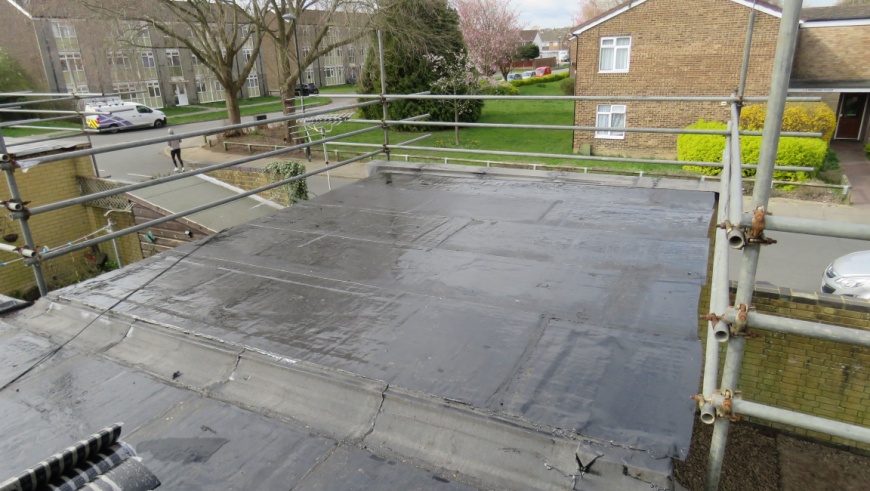
Table of Contents
- How much does a flat roof cost?
- Roofing labour costs & time frames
- What impacts flat roof replacement costs?
- Additional flat roof replacement costs
- What does replacing a flat roof involve?
- What does repairing a flat roof involve?
- Can I replace or repair a flat roof myself?
- Does my flat roof need replacing?
- Does my flat roof need repairing?
- Regulations for flat roof replacements
- What is a green roof?
- Cost of flat roof maintenance
- Flat roof removal cost
- FAQs
- How to find & hire a flat roof specialist
- Sources
How Much Does a Flat Roof Cost?
The average flat roof replacement costs between £700 – £1,300 in the UK. This estimate includes expected material and labour costs. However, the exact cost of a new flat roof will depend on the materials you want to use, the size of the roof, and whether or not scaffolding is required.
Most roofers operate in pairs and will typically charge around £200 – £300 per day.
Typical flat roof replacements will usually take a pair of specialists under a day to complete. However, it's standard practice for them to come back a day or two later to ensure there are no problems with the installation.
The table below shows how flat roof replacement costs per square metre vary depending on the type of material that you want to use.
| Type of Roof | Avg. Cost |
|---|---|
| Felt Roof | £40 – £60 per m² |
| Rubber Roof | £80 – £85 per m² |
| Fibreglass Roof | £70 – £90 per m² |
| Lead Bay Roof | £90 – £105 per m² |
| Fibreglass Bay Roof | £95 – £120 per m² |
As this table shows, the average felt roof costs between £40 – £60 per square metre to have installed. These remain a popular choice amongst homeowners in the UK for looking to replace a flat roof, as they're an affordable and enduring option.
Rubber flat roofs cost around £80 – £85 per square metre to have installed. This type of material is more expensive to install on a flat roof, but it's a more popular choice in the UK. This is because it lasts decades longer than a felt flat roof, is easy to get installed, and is much lower maintenance.
Typically, fibreglass flat roofs cost between £70 – £90 per square metre. They're not as popular amongst homeowners in the UK, but they can be a better choice for flat roofs that aren't square or rectangular than other options.
Before we continue:
Although it might be tempting to put off fixing issues with a flat roof, ignoring these small problems can lead to bigger issues that are more expensive to fix.
Over time, even a professionally installed flat roof will begin to fail. Typically, small leaks are the first sign of deterioration and a sign that it's time to consider the repair or replacement of your flat roof.
Whether you should repair or replace your flat roof depends on the roofing material that you already have and the amount of damage that it has.
New Flat Roof Costs
Here are a few average costs for replacing a flat roof:
| Job Size | Scaffolding? | Avg. Cost | Duration |
|---|---|---|---|
| Single Garage | No | £700 | 1 day |
| Double Garage | No | £900 | 1 day |
| 2-storey Extension | Yes | £1,200 | 1.5 days |
Here is a breakdown of the different roof materials and their costs:
| Roof Type | Average Cost Per m2 |
|---|---|
| Felt roof | £40 - £60 |
| Rubber roof | £80 - £90 |
| Fibreglass roof | £70 - £90 |
| Lead bay roof | £90 - £105 |
| Fibreglass bay roof | £95 - £120 |
Cost of Roof Replacement Material
If you want to take the DIY route, then you will only need to calculate the supply costs. Doing it yourself could help you save a significant amount, especially If you’re planning to replace a roof on a 2-storey extension, as this will allow you to save around £300.
Replacing a Flat Roof
| Roof Material | Average Cost |
|---|---|
| Felt | £2 – £10 per m2 |
| Rubber | £9 – £12 per m2 |
| Fibreglass | £2 – £3 per m2 |
| Lead | £2 – £4 per kg |
| Fibreglass insulation | £6 – £10 per m2 |
| PIR Insulation boards | £5 – £15 per m2 |
| Spray foam insulation | £5 – £12 per spray can |
Repairing a Flat Roof
If your roof is in fairly good condition, it may only require repairs. Here is a breakdown of the material costs for repairing a flat roof:
| Roof Material | Average Cost |
|---|---|
| Base Layer | £40 |
| Mid Layer | £80 |
| Top Layer | £200 |
| Rubber Membrane | £220 |
| Adhesive and Sealant | £50 |
| Edgings and Drip Edge | £140 |
| Resin | £200 |
| Tissue | £30 |
| Topcoat | £130 |
| Trims and Baton | £130 |
| OSB Boards | £100 |
| Clay | £50 |
Flat Roof Replacement Cost Calculator
Individual costs for replacing a flat roof on a 2-storey extension.
Total Cost: £1,200
Materials
£600
Tradesmen
£300
Scaffolding
£300
Roofing Labour Costs & Time Frames
Individual roofers typically charge around £25 per hour, although this will depend on the work being done. They usually only charge around £18 per hour for roof repairs. A lot of roofers work in pairs and will typically charge around £200 – £300 per day in total.
Replacing a roof will take much more time, with the standard duration for the removal and replacement of a single garage roof taking around 7 to 8 hours. A garage roof replacement cost, including labour, will, of course, vary depending on the type of roof you choose. For example, labour for a felt, rubber or fibreglass roof costs around £300 for two tradesmen, although some roofers charge up to £55 per square metre.
What Impacts Flat Roof Replacement Costs?
There are several considerations you need to take into account when assessing roof replacement or flat roof repair costs. The most important being the type of roof you choose, as prices can vary, with a felt roof repair costing an affordable £50 per square metre. Mid-range choices include rubber at £80 per square metre and fibreglass at £90 per square metre.
You may also need to consider what the roof is for, as the bigger the area you want to cover the more expensive it is. The most common roof applications include a garage roof (£1,500), porch roof (£3,000), dormer roof (£4,000), bay window (£7,000) and main roof (£10,000).
You will need to weigh up waste disposal costs when replacing or repairing materials, as the typical expense is around £100 for a tradesman to get rid of any waste.
Additional Flat Roof Replacement Costs
You may also want to consider the following prices before estimating your final flat roof cost:
| Extra Materials | Avg. Cost |
|---|---|
| Scaffolding | £40 – £150 per day |
| Wood Fibre Insulation | £3 – £17 per board |
| Polyisocyanurate Insulation | £4 – £35 per m² |
| Chipping | £5 – £9 per bag |
| Decking Board | £65 – £140 per board |
What Does Replacing a Flat Roof Involve?
Flat roofs are made up of roofing timbers or joists which are laid across walls at a specified distance apart; then they are covered with some sort of boards or sheeting that usually need to be waterproofed. There are many different types of flat roof materials, although EPDM or rubber and fibreglass are the most popular types.
When replacing a flat roof, it makes sense to fit new fascia boards at the same time, as these will have to be removed anyway, so you are already paying the labour for half the job anyway! In addition, a flat roof that has been leaking may also need the roof joists themselves treated or even replaced if they are damp and rotting.
It makes no sense to fit a new roof on top of rotting joists. So a joiner or carpenter may be required, along with a decorator to finish the interior.
To help you understand the replacement process, take a look at the sections below, which cover the different roof types.
Felt Roof
The first step involves using a small spade to separate the felt and the timber underlay. Fascia boards, edgings and trims will also be removed during this process.
The decking will then be measured to establish how much felt you need. The felt will then be layered onto the roof and fitted by nailing it in, making sure to leave an overlap which will protect the roof from adverse weather. The felt may also be secured with adhesive and drilled in fascia boards.
Rubber Roof
To remove rubber roofing, a professional roofer will typically use a utility knife to cut the material into small pieces ready for disposal. A heat gun may also be used to get rid of the membrane section by section.
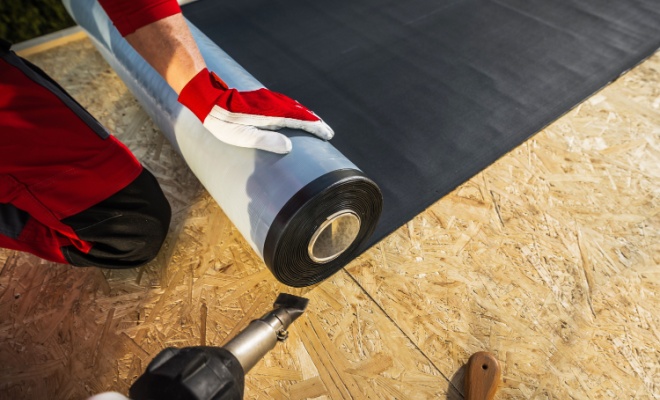
The rubber material will then be measured and applied to the roof using a strong adhesive, which will ensure the rubber is secure and will last a long time.
Fibreglass Roof
If your fibreglass roof is falling apart or damaged, then it will need to be removed before replacing it. The roof material should come away easily with the help of a shovel, although some force may have to be applied if it is not loose.
Once the existing roof has been removed, and the decking and laminate trims are in place, the edges should then be bandaged to keep everything in place. The material will then be measured and laid out on the roof. Once everything is in line, the resin will then be applied to wet the decking. Another resin layer should then be applied to secure it onto the roof.
Lead Roof
To remove lead material, your tradesmen will use a diamond-tipped small-angle grinder. They will go no deeper than 15 to 20 mm and will tend to use a screwdriver to remove the tiles thoroughly.
The lead will then be measured, laid out and slightly onto the top of your roof. Rolled-up lead should then be hammered between the brickwork and the wall to create a secure structure.
What Does Repairing a Flat Roof Involve?
Typically a flat roof repair job will involve essentially re-waterproofing a section of the roof, although many other repairs can be undertaken depending on the type of roof you have.
Felt Roof
If you have a felt roof, then any leaks may cause blistering. The felt repair process for this involves cleaning the surface and removing any mould. A tradesman will then use a heat gun to heat up the area where the leak occurred, making sure that they do not apply too much pressure as felt can melt easily.
Once it is completely dry, the adhesive will be applied to the area, and a new piece of felt will be put in its place and secured with more adhesive.
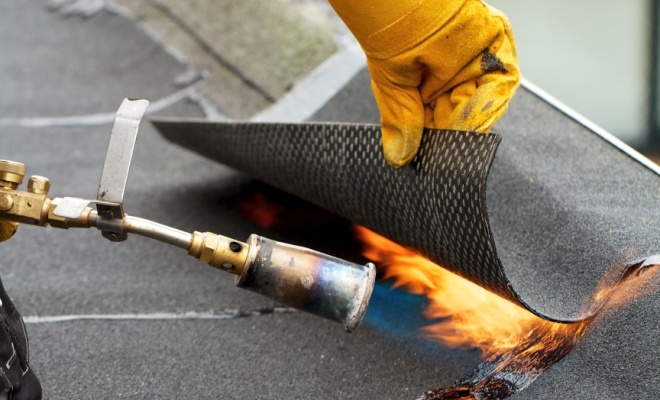
A similar process applies if there are any splits in the material or it starts to overlap, as this will be caused by water damage and should be repaired as soon as possible.
Rubber Roof
When repairing a rubber roof, no asphalt-based products must be used as rubber is not compatible with these materials, and if they are used, an entire replacement would be required. To avoid extra costs, a qualified tradesman will use simple household cleaners to treat the area and remove dirt, including the carbon that rubber releases over time. This must be removed to allow the new materials to stick.
EPDM roofing primer will then be used to prepare the damaged area. A pressure-sensitive patch or a glue-down path will then be applied to the area, making sure that it fits exactly and does not overlap. This should then be sealed with EPDM lap sealant around the patch’s perimeter then smoothed out and secured.
Fibreglass Roof
One of the most common issues with a fibreglass roof is holes and cracks. To repair this type of damage, a disc sander will be required to clean the area and remove any damaged material, followed by a thorough cleaning of the area with acetone.
Resin and catalyst should then be mixed and applied to the affected area; then it is left to set. Once set, it should then be sanded down and levelled. Two layers should then be cut to size, with one the same size as the damaged area and one slightly smaller. Mixed resin should then be applied again before installing the fibreglass material.
To finish off the job, your chosen tradesmen will sand down the area once it is cured, then apply a waterproof top coat to enable your roof to keep as long as possible.
Lead Roof
Lead roof repairs are usually conducted due to cracks caused by heat expansion of the main roof material and flashings. If left, they can lead to a significant amount of damage, despite the cracks being almost invisible on occasion.
To fix the hole or crack, your tradesman may decide to use a paint-on roof sealer. However, this may not be the best decision as it can actually make a repair job much harder. Instead, the best way to repair a lead roof is by welding a piece of lead onto the damaged area.
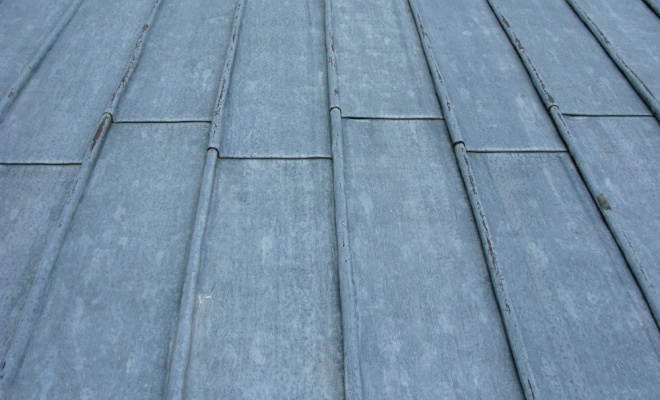
Flashing tape can also be used to secure the roof material along with a primer, which acts as an adhesive to secure the lead in place. However, this is not a permanent solution, unlike welding, which is definitely the preferred option for professionals.
Can I Replace or Repair a Flat Roof Myself?
Some flat roof repairs can be done on a DIY basis; there are various waterproofing and sealant materials which are effective in tackling temporary repairs, giving you time to gather quotes and save up for long-term professional repairs.
You can even buy paint on 'waterproofer', which is an emergency roof repair in a tin that costs around £10 per litre. You can also purchase roof repair kits — which include resin, catalyst, roof material, tape and topcoat. There are many kits available for each type of roof, although the average price is around £45 for small repair kits and up to £300 for leaking roof repair kits.
To complete the job, you may also require a number of tools including:
- Utility knife (£2 – £19)
- Crowbar (£4 – £25)
- Shovel (£10 – £37)
- Nail gun (£30 – £550)
- Heat gun (£20 – £690)
- Hammer (£3 – £28)
If damage to the roof is localised to just a small area, a repair may be the best option, rather than replacing the entire roof. However, if you cannot fix the roof material yourself on a DIY basis, it may be more cost-effective to bring in a contractor to replace the roof completely rather than paying them for small and temporary repairs.
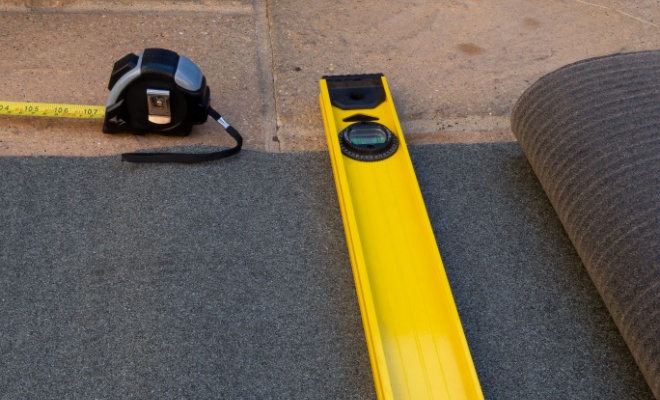
In many cases, making repairs to a flat roof is a complete waste of money; for example, if the roof timbers underneath are damaged, then a complete replacement is best instead of a repair. In addition, some roofing materials are difficult to patch in small damaged areas without damaging the rest of the roof, thereby making things even worse.
Does My Flat Roof Need Replacing?
While it may seem cheaper to repair your roof in the short-term, it is much better to replace your roof before you end up with extensive damage on your roof and inside your home.
You will find that some roof types will last longer than others. For example, a felt flat roof usually lasts around 10 to 15 years, while a fibreglass roof should be replaced after 20 years. A more durable material is rubber membrane, which has a lifespan of 40 years, although the most long-lasting of all is lead, which can last as long as 60 years.
One of the main problems flat roof owners face, regardless of the material, is leaking, which cannot only cause leaks but will also force the timber decking to rot. If this occurs often, you may need to have your roof replaced to prevent any further water damage or rot.
Does My Flat Roof Need Repairing?
If you have noticed any water dripping from the ceiling, this could be due to a hole, split, or blister on your roof material or flashing which can be susceptible to rips. You may be able to notice this on materials such as rubber or felt; however, other materials, such as lead, may be more subtle.
Another common issue is water pooling, which causes a build-up of water that may cause a leak. To prevent any further damage, you should repair the issue as soon as possible.
Regulations for Flat Roof Replacements
For repairs or partial replacement of less than 25% of your roof, you will not need planning permission. However, you will need to apply if you are planning to conduct the following:
- You are replacing or repairing more than 25% which would require the insulation to be improved.
- Carry out structural alterations.
- The quality of the roof material will be significantly different.
If you do require planning permission, then you could cost anywhere between £206 – £462 depending on the extent of the roof work.
What Is a Green Roof?
A green roof involves the installation of a waterproof underlay covered in grass and plants, which can also feature a drainage system that is a great way to combat flooding.
One of the main advantages of having a green roof is that it preserves water, and instead of being wasted, it is released back into the environment.

Having a green roof installed could cost anywhere from £50 – £100 per square metre for an extensive green roof to £150 – £200 per square metre for an intensive green roof which features deeper roots for large plants.
Despite the initial cost, having a green roof installed can help you reduce your energy bills, as it is one of the most energy-efficient features you can have outside your home. You can also benefit from 25% compensation for your overall costs if you install a green roof on 50% of your property.
Another benefit of a green roof is that it is great at preserving water, which is great for the environment as less water is being wasted. A green roof also has a lifespan of 50 years due to its green covering which acts as a barrier against the elements which cause rusting or mould on typical roof applications.
Cost of Flat Roof Maintenance
To prevent regular repairs or an entire replacement, you should try to look after your roof as much as possible. This involves checking your roof at least twice a year, especially when there are significant weather changes which may cause damage to your roof. Make sure to look inside as well at any potential leaks in your ceiling, as this will be an indicator of damage forming.
You should also try to remove as much debris as possible, as this will help to prevent mould or algae growth on your roof and gutters, which will also deter water pooling. To reduce the time spent on this chore, you could consider purchasing a pressure washer which can range from £70 for a basic pressure washer to £2,000 for high-quality pressure washers.
If you have any trees surrounding your home, you should try to keep on top of them by either cutting them down or trimming the trees regularly, as this will reduce the amount of debris on your roof. You may want to hire a professional tree surgeon to do this, who will charge around £120 per hour for jobs such as pollarding which will reduce foliage.
However, if you want any trees removing, this could cost from £150 – £750 for small to medium trees, while large and extra-large trees could cost around £650 – £2,500.
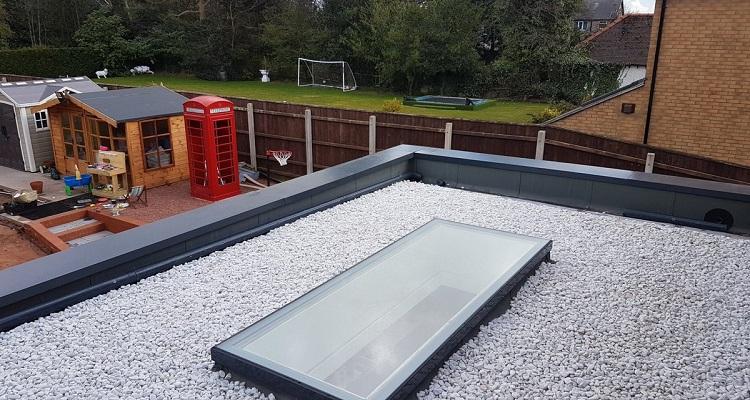
There are many ways to preserve your roof, although this will depend on the type of material used. For example, EPDM rubber is susceptible to shrinkage, so to prevent this, you may want to use ballast to make your roof more robust. This usually costs around £2 for a large bag and up to £40 for a bulk bag.
Those with a fibreglass roof can prevent replacement or repairs by regularly applying acrylic paint to their roof covering. This will not only make it look brand new but will also protect the insulation and prevent a build of internal moisture – acrylic paint costs around £9 – £170 per tin.
Flat Roof Removal Cost
If you want to convert your roof, you will need to have your flat roof completely removed. It may be that you have no choice due to consistent leaking or rotted timber decking, which will require you to remove your roof. The average cost for professional removal is around £80 per square metre, although this will depend on the material used, as some may be harder to remove than others.
You will also need to consider waste disposal costs, which usually amount to £100 if a tradesman is removing it for you. If you need to hire a skip, expect to pay around £200 – £1,000 for skip hire.
FAQs
This figure would include the removal of the existing roof felt, an inspection of existing timber, supply and installation of underlay, supply and installation of the cap sheet, supply and installation of all edgings, and the disposal of all waste material from the site.
The cost would increase for a flat roof in a habitable part of the building as more insulation would be required. The presence of asbestos in the old roof would also considerably increase costs, as would access or height problems requiring scaffolding.
Removing the old felt is an essential part of the job as the timbers underneath need to be inspected or replaced. This will last for a year or less until the movement of the roof, UV rays from sunlight, and damaged existing roof cause it to split and leak.
Unusually shaped flat roofs or roofs where there is a lot of cutting around roof windows or pipes required will take longer, as will flat roofs on second or third storeys which will require scaffolding or access towers.
There are three main types of flat roofing. This includes built-up roofing (which features layers of felt and gravel), Modified Bitumen Roofing (which is made up of asphalt-based material )and membrane roofing (which usually features EPDM rubber and plastic).
Flat roof repair costs are more affordable than replacing the entire roof. However, sometimes it might be a more cost-effective and longer-term solution to replace the roof if it's coming to the end of its expected lifespan.
How to Find & Hire a Flat Roof Specialist
The average roofer charges between £18 – £25 per hour.
The prices you're quoted will depend on what you're looking to have done, the size of the job, the experience of the tradesperson, and where you're located in the UK.
To ensure that you are hiring a reliable worker, you should check they have more than 5 years’ experience roofing, and that they have public liability insurance to protect them, and you, in the event of an accident.
You may also want to check if they have a diploma in roof slating and tiling. However, this isn't a legal requirement to become a skilled roofer.
Ready to find a roofing specialist near you?
Get up to 3 FREE quotes from local tradespeople.
Sources
https://www.doityourself.com/stry/how-to-remove-a-rubber-roof-membrane
https://www.wikihow.com/Replace-a-Flat-Roof
https://gooforit.co.uk/product/fibreglass-hole-repair-kit/
https://www.gee-grpfibreglassing.co.uk/cleaning-maintenance-of-a-grp-roof/
https://www.dctaylorco.com/blog/shrinkage/
https://science.howstuffworks.com/environmental/green-science/green-rooftop.htm
https://homeli.co.uk/5-examples-of-living-green-roofs-grass-turf-and-succulent-sedums/
https://www.viritopia.com/blog/where-find-sedum-and-green-roof-supplies
https://lifetimeroofing.com/flat-roof-advantages-and-disadvantages/
https://www.aabcoroofinginc.com/pros-and-cons-of-rubber-roofing/










